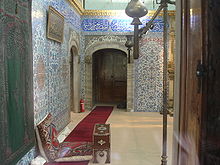Mantle of the Prophet
The Prophet's cloak or Hırka-i Şerif , "the noble cloak", is the name of a cloak ascribed to the Prophet Mohammed . The cloak was venerated as a relic and is kept in the Emanat-ı mukaddese in the Topkapı Palace . Another name is Hırka-i Saadet ("coat of happiness"). The coat has a length of 1.24 m. It is black, lined with cream-colored wool and has long and wide white sleeves. Small pieces of fabric are missing in several places. It is kept in a silver-studded chest. The importance and protective effect attached to a cloak of the Prophet emerges from the history of the people in the cloak .
According to tradition, Mohammed is said to have given the cloak to Ka'b ibn Zuhair . Muawiya is said to have bought the coat after his death. Later it passed into the possession of the Abbasids and after the conquest of Baghdad by the Mongols came to Egypt. It came to Istanbul in the course of the conquest of Egypt by Selim I in 1517. There it was kept in the so-called Has Oda , the “private room” of the palace. Forty people, the so-called Has Odalılar , were charged with protecting and caring for the relic.
The mantle was venerated as a sanctuary by the sultans. Sultan Mustafa II even took the cloak with him when he tried to escape after he was disempowered. The prophet's mantle was the subject of various ceremonies. Some sultans wetted it in water, which was thereby sanctified and then given away as a token of special favor. The sultans also used to give away cloths with which the cloak was rubbed off as gifts of honor. On the 15th of Ramadan the coat was honored with a solemn procession of the highest religious and secular dignitaries of the empire . After a common midday prayer , they moved to Has Oda . After being allowed to enter, the Sultan gave them permission to touch the cloak with their face ( yüz sürmek ) after reciting the Quran .
The coat served the Ottoman rulers as a source of legitimation and was also used to turn the luck of the battle. Mehmet III. used this remedy successfully in his campaign to Egri. The cloak also played a role in state acts such as swearing-in, sword-girding of new sultans and the death of sultans.
Another coat attributed to the Prophet came to Istanbul in 1617 or 1618. This coarser coat is said to have originally been in the possession of Uwais al-Qarani , a contemporary of the Prophet. It is located in a mosque specially built for the Hırka-i Şerif, the Hırka-i Şerif Camii. This elegant mosque, modeled on European architecture, was built around 1850 by Sultan Abdülaziz 's mother . The coat is open to the public there between the 15th of Ramadan and the night of determination .
Individual evidence
- ^ Annemarie Schimmel: Deciphering the signs of God: a phenomenological approach to Islam. State University of New York Press 1994, p. 37
- ^ EJ Brill's First Encyclopaedia Of Islam, 1913–1936, Leiden 1987, Vol. IV. Keyword: KHIRKA-I SHERIF
- ↑ Klaus Kreiser: Istanbul: a historical-literary city guide, Munich 2001, p. 101
- ^ The Encyclopaedia of Islam. New Edition , sv KHIRKA-YI SHERIF
literature
- Nurhan Atasoy in: The Encyclopaedia of Islam. New Edition , sv KHIRKA-YI SHERIF
- Cl. Huart in: EJ Brill's First Encyclopaedia Of Islam, 1913-1936, Leiden 1987, Vol. IV. Keyword: KHIRKA-I SHERIF
- Klaus Kreiser: Istanbul: a historical-literary city guide, Munich 2001, p. 100f.
